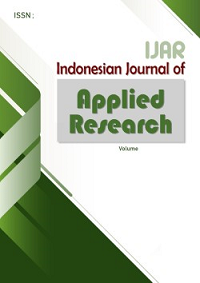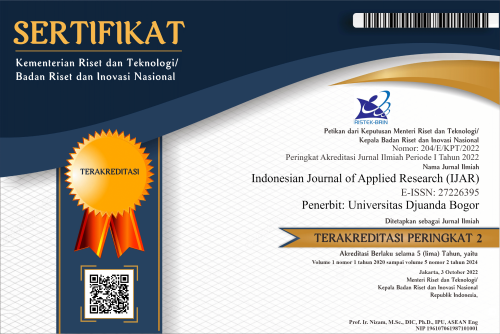Total Phenolics, Flavonoids, and Antioxidant Activities of Indonesian Apis Dorsata Honey Due to Heating
Abstract
Honey is rich in phenolic and flavonoid compounds that have the potential as antioxidants. The heating treatment of honey is also known to affect the honey compound. This study aimed to determine the best Indonesian A. dorsata honey from various locations based on the level of total phenolics compounds, flavonoids, and antioxidant capacity due to variations in heating temperature. The procedures carried out in this study included: heating the sample with variations (room temperature, 65 oC, and 121 oC), measuring total phenolic content using the Folin-Ciocalteau method, measuring total flavonoid content using the AlCl3 colorimetric method, and testing antioxidant activity using the DPPH method. Each honey's total phenolic, flavonoid, and antioxidant activity are affected by its origin. The impact of heating at 65 oC and 121 oC resulted in various changes between honey samples (p<0.05). The best A. dorsata honey overall was found in Flores honey after heating at 121 oC heating treatment with total phenolic content of 4.96 mgGAE/mL, total flavonoids of 1.173 mg QE/mL, and IC50 5.76 g/L.
References
Abdullah, W., Runtuwene, M. R. J., & Kamu, V. S. (2014). Uji fitokimia dan penentuan inhibition concentration 50% pada beberapa tumbuhan obat di Pulau Tidore. Jurnal Ilmiah Sains, 14(2), 95-99. https://doi.org/10.35799/jis.14.2.2014.6063
Aydogan-Coskun, B., Coklar, H., & Akbulut, M. (2019). Effect of heat treatment for liquefaction and pasteurization on antioxidant activity and phenolic compounds of Astragalus and sunflower-cornflower honeys. Food Science and Technology, 40(3), 629-634. https://doi.org/10.1590/fst.15519
Badan Meteorologi Klimatologi dan Geofisika. (2021). Analisis Hujan Juli 2021 dan Prakiraan Hujan September, Oktober, dan November 2021. Jakarta: BMKG. https://karangploso.jatim.bmkg.go.id/index.php/buku/4087-buku-edisi-setiap-1-bulan-sekali/buku-analisis-dan-prakiraan-bulanan-jawa-timur/buletin-bulanan-analisis-dan-prakiraan-hujan-di-provinsi-jawa-timur-tahun-2021/555558889-buletin-bulanan-analisis-hujan-bulan-juli-tahun-2021-dan-prakiraan-hujan-bulan-september-oktober-november-tahun-2021-provinsi-jawa-timur.
Badan Standardisasi Nasional, B. S. (2013). SNI Madu. Badan Standardisasi Nasional.
https://pesta.bsn.go.id/produk/detail/9529-sni35452013.
Cahyaningrum, P. L. (2019). Aktivitas antioksidan madu ternakan dan madu kelengkeng sebagai pengobatan alami. Widya Kesehatan, 1(1), 1-6. https://doi.org/10.32795/widyakesehatan.v1i1.279
Chaaban, H., Ioannou, I., Chebil, L., Slimane, M., Gerardin, C., Paris, C., Charbonnel, C., Chekir, L., & Ghoul, M. (2017). Effect of heat processing on thermal stability and antioxidant activity of six flavonoids. Journal of Food Processing and Preservation, 41(5), 1-12. https://doi.org/10.1111/jfpp.13203
Chaikham, P., Kemsawasd, V., & Apichartsrangkoon, A. (2016). Effects of conventional and ultrasound treatments on physicochemical properties and antioxidant capacity of floral honeys from Northern Thailand. Food Bioscience, 15, 19–26. https://doi.org/10.1016/j.fbio.2016.04.002
Elamine, Y., Anjos, O., Estevinho, L. M., Lyoussi, B., Aazza, S., & Miguel, M. G. (2020). Effect of extreme heat processing on the Moroccan Zantaz’ honey antioxidant activities. Journal of Food Science and Technology, doi:10.1007/s13197-020-04365-x.
Escriche, I., Kadar, M., Juan-Borrás, M., & Domenech, E. (2014). Suitability of antioxidant capacity, flavonoids and phenolic acids for floral authentication of honey. Food Chemistry, 142, 135–143. https://doi.org/10.1016/j.foodchem.2013.07.033
Fauzi, N. A., Farid, M. M., & Silva, F. V. M. (2013). High-pressure processing of manuka honey: improvement of antioxidant activity. Food and Bioprocess Technology, 7(8), 2299–2307. https://doi.org/10.1007/s11947-013-1204-7
Gul, A., & Pehlivan, T. (2018). Antioxidant activities of some monofloral honey types produced across Turkey. Saudi Journal of Biological Sciences, 25, 1056–1065. https://doi.org/10.1016/j.sjbs.2018.02.011
Hasan, A.E.Z., D. Andrianto, A. Rahmania, I.G.C. Ahmada, R.M. Abdillah. 2021. Effect of Heating on Flavonoid Concentration in Honey Harvested from Across Indonesian Archipelago. Pharmacologyonline. 3: 615-623.
Kocadağlı, T., & Gökmen, V. (2019). Caramelization in Foods: A Food Quality and Safety Perspective. Encyclopedia of Food Chemistry, 18–29. https://doi.org/10.1016/b978-0-08-100596-5.21630-2
Meteorology Climatology and Geophysics Council. (2021). Analisis Hujan Juli 2021 dan Prakiraan Hujan September, Oktober, dan November 2021. Jakarta: BMKG. https://iklimbantendki.id/berita.
Molaveisi, M., Beigbabaei, A., Akbari, E., & Noghabi, M. S. (2019). Kinetics of temperature effect on antioxidant activity, phenolic compounds and color of Iranian jujube honey. Heliyon, 5, 1-14. https://doi.org/10.1016/j.heliyon.2019.e01129
Moniruzzaman, M., An, C. T., Rao, P.V., Hawlader, M. N. I., Azlan, S. A. B. M., Sulaiman, S. A., & Gan, S. H. (2014). Identification of phenolic acids and flavonoids in monofloral honey from Bangladesh by high performance liquid chromatography: determination of antioxidant capacity. BioMed Research International, 1–11. https://doi.org/10.1155/2014/737490
Mutiah, R., Yuliandari, A., Annisa, R., & Ma’arif, B. (2018). Metabolomic analysis of Dendrophthoe pentandra (L.) Miq. leaves via UPLC-QToF-MS coupled with multivariate data analysis using PCA. Proceedings of the 2nd International Conference on Quran and Hadith Studies Information Technology and Media in Conjunction with the 1st International Conference on Islam, 2018 Okt 2-4, Bandung, Indonesia. https://doi.org/10.4108/eai.2-10-2018.2295577
Olas, B. (2020). Honey and Its Phenolic Compounds as an Effective Natural Medicine for Cardiovascular Diseases .in Humans. Nutrients, 12(283), 1-14. https://doi.org/10.3390/nu12020283
Rahardjo, M., Sihombing, M., & Anggraeni, M. K. (2020). Color development and antioxidant activity in honey caramel. IOP Conference Series: Earth and Environmental Science, 443(012041). https://doi.org/10.1088/1755-1315/443/1/012041
Sanchez, A. L. B., Salazar, B.Q., Garcia, O. D., & Buendia, H. B. E. (2021). Phenolic compounds in honey and their relationship with antioxidant activity, botanical origin, and color. Antioxidants, 10(11), 1-23. https://doi.org/10.3390/antiox10111700
Singh, I., & Singh, S. (2018). Honey moisture reduction and its quality. Journal of Food Science and Technology, 55(10), 3861-3871. https://doi.org/10.1007/s13197-018-3341-5
Sumarlin, L. O., Hadera, M., Chalid, S. Y., & Sukandar, D. (2018). Aktivitas antioksidan kombinasi madu monoflora dengan ekstrak daun namnam (Cynometra cauliflora L.). Alchemy: Journal Of Chemistry, 6(1), 10-17. https://doi.org/10.18860/al.v6i1.4736
Utomo, D. S., Kristiani, E. B. E., & Mahardika, A. (2020). Pengaruh Lokasi Tumbuh Terhadap Kadar Flavonoid, Fenolik, Klorofil, Karotenoid dan Aktivitas Antioksidan Pada Tumbuhan Pecut Kuda (Stachytarpheta Jamaicensis). Bioma: Berkala Ilmiah Biologi, 22(2), 143-149.
Werdhasari, A. (2014). Peran antioksidan bagi kesehatan. Jurnal Biotek Medisiana Indonesia, 3(2), 59-68.
Zarei, M., Fazlara, A., & Tulabifard, N. (2019). Effect of thermal treatment on physicochemical and antioxidant properties of honey. Heliyon, 5(6), 1-6. https://doi.org/10.1016/j.heliyon.2019.e01894
Copyright (c) 2023 Indonesian Journal of Applied Research (IJAR)

This work is licensed under a Creative Commons Attribution-ShareAlike 4.0 International License.
The Authors submitting a manuscript do so on the understanding that if accepted for publication, copyright publishing of the article shall be assigned/transferred to Indonesian Journal of Applied Research (IJAR) Universitas Djuanda as Publisher of the journal. Upon acceptance of an article, authors will be asked to complete a 'Copyright Transfer Agreement'. An e-mail will be sent to the corresponding author confirming receipt of the manuscript together with a 'Copyright Transfer Agreement' form by online version of this agreement.
Indonesian Journal of Applied Research (IJAR) Universitas Djuanda, the Editors and the Editorial Board make every effort to ensure that no wrong or misleading data, opinions or statements be published in the journal. In any way, the contents of the articles and advertisements published in the Indonesian Journal of Applied Research (IJAR) Universitas Djuanda are sole and exclusive responsibility of their respective authors and advertisers.
Remember, even though we ask for a transfer of copyright, our journal authors retain (or are granted back) significant scholarly rights as mention before.
The Copyright Transfer Agreement (CTA) Form can be downloaded here: Copyright Transfer Agreement-IJAR 2020
The copyright form should be signed electronically and send to the Editorial Office e-mail below:
Prof. Dr. Ir. Dede Kardaya, M.Si. (Editor-in-Chief)
Universitas Djuanda
Jl. Tol Jagorawi No.1, Ciawi, Kec. Ciawi, Bogor, Jawa Barat 16720
Website: http://journal.unida.ac.id/index.php/IJAR/index
Email: ijar@unida.ac.id






 This work is licensed under a
This work is licensed under a 